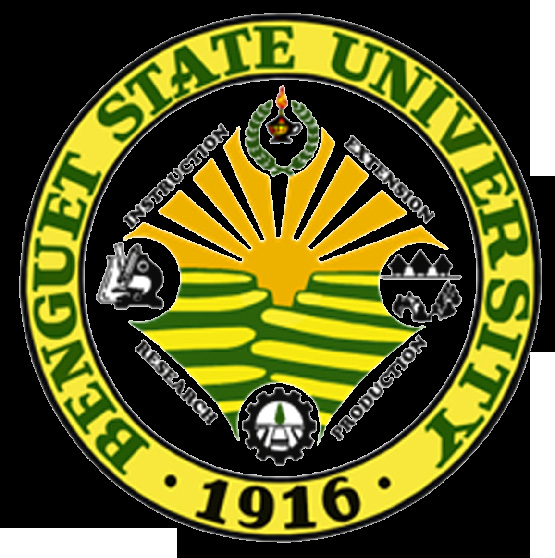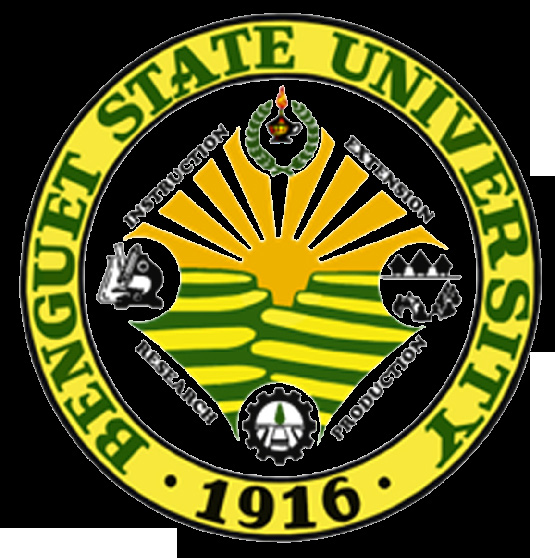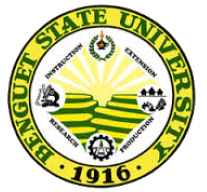Benguet State University RESEARCH JOURNAL ISSN 0117-5297 ...

Benguet State University
RESEARCH JOURNAL
ISSN 0117-5297 No. 66 January-June 2011
CONTENTS
MORPHOLOGICAL DIVERSITY ANALYSIS OF RICE
LANDRACES IN BENGUET. . . . . . . . . . . . . . . . . . . . . . . . . . . . . . . . . . . . . . . . . . . . . . . . . . . . . . . 1-13
B. A. Tad-awan and E. J. D. Sagalla
PERCEPTIONS ON GLOBAL CLIMATE CHANGE
AT BENGUET STATE UNIVERSITY. . . . . . . . . . . . . . . . . . . . . . . . . . . . . . . . . . . . . . . . . . . . . . . . 15-34
J. L. S. Ramos and B. O. Bua-ay
RASCH ANALYSIS OF THE NBC 461 INSTRUMENT
FOR FACULTY EVALUATION. . . . . . . . . . . . . . . . . . . . . . . . . . . . . . . . . ..... . . . . . . . . . . . . . . . . 35-42
M. A. B. Lubrica and J. V. Lubrica
SECULARIZATION OF THE SACRED:
BENDIAN THROUGH THE PASSAGE OF TIME. . . . . . . . . . . . . . . . . . . . . . . . . . . . . . . . . . . . . . 43-74
F. Y. Awas
BENGUET STATE UNIVERSITY
La Trinidad 2601 Benguet
Philippines
All communications should be addressed to:
THE EDITOR
BSU Research Journal
Benguet State Univeristy
La Trinidad, Benguet 2601, Philippines
Telefax:( +6374) 422-5547
Email address: bsupublications@gmail.com or
repo@bsu.edu.ph
Website: www.bsu.edu.ph

Benguet State University
RESEARCH JOURNAL
This multidisciplinary scientific journal publishes selected
papers but not limited to those presented during the
annual Benguet State University Agency In-House Review
(Agriculture, Forestry and Natural Resources, Social and
Education Sectors).
Editorial Board
EDITOR
Wilma L. Marquez
Lay-out Artist/ Circulation Assistant
May Flor P. Magciano
TECHNICAL EDITORS
Percival B. Alipit, PhD, Agriculture and Horticulture
Ruth S. Batani, MSc, Social Science and Sociology
Jovita M. Sim, MSc, Agricultural Economics and Agribusiness
Janet S. Luis, PhD, Agriculture and Plant Pathology
Julia A. Solimen, PhD, Extension Education and Social Science
EDITORIAL CONSULTANTS
Julia A. Solimen, PhD
Rogelio D. Colting, PhD
Ben D. Ladilad, PhD
REFEREES
Delfin Tolentino
Cordillera Studies Center, University of the Philippines-Baguio
Dindo A. Tabanao
Plant Breeding and Biotechnology Division, Philippine Rice
Research Institute
George K. Ramos
Saint Louis University, Baguio City
Raymundo D. Rovillos
College of Social Science, University of the Philippines-Baguio
Benguet State University Research Journal (BRJ) January-June 2011, 66: 1-13
Copyright 2011, Benguet State University
MORPHOLOGICAL DIVERSITY ANALYSIS OF RICE LANDRACES
IN BENGUET
Belinda A. Tad-awan and Esther Josephine D. Sagalla
College of Agriculture
Benguet State University
ABSTRACT
The research was conducted to: collect germplasm of rice landraces in Benguet;
to characterize germplasm of collected rice landraces in Benguet; to determine diversity
in the collections and relationships among the collected rice landraces, and; to maintain
a gene bank of collected rice landraces.
Germplasm collection, morphological characterization, diversity and cluster
analysis, and bi-plot analysis were performed on 157 rice landraces collected from the
12 municipalities of Benguet.
Most of the rice landraces were collected from Kibungan, Kapangan, and Bakun.
The grain characterization of the rice plants revealed that Sabul and Tudoy had desirable
characters on high yield and pest resistance. Pitkikil and Mayok, on the other hand,
exhibited long roots and high number of tillers.
A low mean diversity index was observed in both the grain and vegetative
characters of the rice landraces indicating homogeneity among the landraces collected.
Cluster and bi-plot analysis on grain characters revealed seven clusters. Cluster
seven appears to be associated with high yield. In addition, the same analysis on vegetative
characters resulted in three clusters with cluster three appearing to be associated with
long roots.
Keywords: Rice landraces, morphological diversity analysis, germplasm
Benguet State University Research Journal (BRJ) January-June 2011, 66: 15-34
Copyright 2011, Benguet State University
PERCEPTIONS ON GLOBAL CLIMATE CHANGE AT BENGUET STATE
UNIVERSITY
Jennifer Lyn S. Ramos and Brenda O. Bua-ay
College of Arts and Sciences
Benguet State University
ABSTRACT
Climate change is a global issue. The academe plays an important role in
disseminating information about climate change; one way is by conducting surveys. This
study investigated the perceptions and level of awareness on global climate change of the
different sectors in Benguet State University. Through cluster sampling, three hundred
sixty (360) respondents were used comprising of four sectors – administrators, faculty,
students, and non-teaching personnel. The different sectors in the university have similar
perceptions on climate change - it is real and harmful; human activities that caused
it are pollution due to industry; it concerns them and must be addressed by everyone
including BSU; and actions can be done to address it whether at home or in the campus
such as waste segregation and tree planting. On their level of awareness, the respondents
are highly aware of climate change as a global issue; ways/devices/methods that help
mitigate climate change impact such as more efficient cars/appliances and alternative
energy sources; and on the difference that an individual and an institution can make on
the projected impacts of climate change. Overall, there are no significant differences on
the perceptions and level of awareness on climate change among the sectors. However,
significant differences were noted according to the sectors’ level/amount of exposure,
basis of beliefs, and access to information. There seems to be room for improvement
with respect to what BSU is doing to address climate change as indicated by the low
percentage of respondents who believe BSU is doing its part to address climate change.
BSU as an academic institution has an important role to play in alleviating the effects
of climate change within the community and the municipality. It should create more
avenues for the involvement of all the sectors in the university in its campaign on climate
change mitigation especially on its Eco-Waste Management Program and allow for better
participation on the Information, Education, and Communication (IEC) arm of the said
program.
Keywords: Climate change, perceptions, level of awareness, academe, survey
Benguet State University Research Journal (BRJ) January-June 2011, 66: 35-42
Copyright 2011, Benguet State University
RASCH ANALYSIS OF THE NBC 461 INSTRUMENT
FOR FACULTY EVALUATION
Maria Azucena B. Lubrica and Joel V. Lubrica
College of Arts and Sciences
Benguet State University
ABSTRACT
Responses of university students to a 20-item Student Evaluation of Faculty
Instrument having a 5-point Likert-type scale were analyzed through Rasch Measurement
Theory. The primary aims were to determine: a) the reliability of the Instrument in
measuring faculty performance; and, if each item in the Instrument can be considered
as an indicator of performance. Participants were from 882 students of various degree
programs in Benguet State University, who rated seven teachers. Results revealed that,
as a whole, the Instrument was reliable and that seventeen of the items can be considered
as independent indicators of performance. The other three items might need to be re-
phrased so that they can also become indicators.
Keywords: Faculty evaluation; Rasch analysis
Benguet State University Research Journal (BRJ) January-June 2011, 66: 43-74
Copyright 2011, Benguet State University
SECULARIZATION OF THE SACRED : “BENDIAN ”
THROUGH THE PASSAGE OF TIME
Filmore Y. Awas
College of Agriculture
Benguet State University
ABSTRACT
This study is designed to document how Bendian evolved from a ritual to what is now called as
“staged performance” and how cultural integrity and community development was promoted though its
staging. It is therefore intended to look into the process of community dialogue leading to community
action that affects the welfare of the community especially in terms of the maintenance of cultural
integrity and the promotion of tourism. The study is limited to the documentation of the experiences
and processes.
Findings show that the process of dialogue that the community people continuously observed
determined the evolution of Bendian with the following enabling factors: politics, education, economic
condition of the community, and tourism. The staging of Bendian provided an avenue for exchange of
ideas and sharing of values, principles, characteristics and values of the community members making
them feel the process of change and the process of development.
Based on the ECIP framework, the cultural integrity of the staged performance was maintained.
The staging also played a big role in the intergenerational transmission of knowledge and values.
Religion, education, lack of interest of the youth, lack of resources, opposition of parents, personal
convictions of a member of the community, death of elders, time constraints, and lack of documentation
were considered as a challenge in the development of cultural integrity in the community.
In conclusion, the evolution of Bendian from a sacred healing ritual to a secularized medium is
a manifestation of a cultural change influenced by internal and external forces. The process of dialogue
that the community people continuously observed, however, determines the integrity of these changes.
In relation to development, it is through careful and conscious examination and understanding of
these changes can the community become more able to mainstream the concept of culture into the
development process.
Continuation of such practice in a form of stage performance is strongly recommended. With
regards to the boundaries of change that must happen, community dialogue should be continued and
properly observed together with the elders of the community. A follow-up study must also be conducted
to assess the impact of cultural tourism in the municipality.
Abbreviation used: ECIP - Episcopalian Commission on Indigenous Peoples
IP -Indigenous People
Keywords: bendian, culture, indigenous people, community dialogue and stage performance
INFORMATION FOR CONTRIBUTORS
(Abridged/improved from the editorial policies of the Benguet State University)
1. All manuscripts must be the result of research activities (technical or social) that are relevant to the development
thrust of the University and should not have been published elsewhere.
2. Acceptance of manuscript is on the basis of the review and approval by a corps of technical editors and selected
referees.
3. Original photos should be submitted in PNG or JPEG format with corresponding captions.
4. The manuscript should not exceed 40 pages, typed double spaced in 12-point Times New Roman on one side of
81/2” paper with margins of 3.81 cm on the left and 2.54 cm top, right and bottom and must be submitted in hard
and electronic copy via bsupublications@gmail.com using MS Word Program.
5. The manuscript should be organized in the following order: (a) Title; (b) Authors/s; (c) Authors/s position;
(d) Abstract; (e) Introduction; (f) Materials and Methods; (g) Results and Discussion; (h) Conclusions and
Recommendations; (i) Acknowledgment, optional; and (j) Literature Cited ; and written all centered.
6. The title should be a precise and concise description of the contents of the manuscripts without abbreviations and
typed in upper case. If the paper is a portion of a larger manuscript, which shall be serialized and will be indicated
in a superscript followed by a brief explanation.
7. The author(s) name(s) is/are written in this way: initial letter for the middle names only, first and family names in
full and typed in title case. Senior author comes first in case of more than one author.
8. The abstract must be 200 words or less, summarizing the main points of the articles.
9. The introduction should contain scope and statement of the problem, brief survey of previous work and objectives
and importance of the study.
10. Citations in the text follows the name and year system, e. g.
Single Author:
(Adeyemo, 2010), Yeo (2009) or Boquiren (n.d.)
Two Authors:
Pladio and Villasenor (2004), (Pladio and Villasenor, 2004)
More than Two Authors:
Folbre et al. (2011) or (Folbre et al., 2011).
11. Materials and methods should describe very concisely but comprehensively the materials used, techniques, and
lay-out of the research.
12. Scientific names and other foreign expressions such as in situ, et al., i.e., and other similar expressions are italicized.
Technical terms, abbreviations and acronyms must be defined.
13. In abbreviating or using acronyms, the System International-Units (SI) of the metric system should be followed.
Such abbreviations or acronyms should be written first in full before the truncated terms in parenthesis, e.g. thin-
layer chromatography (TLC). If this information is given in the abstract, it should be re-identified when mentioned
the first time.
14. The results should be presented logically and in objective way and conclusions stated as valid facts.
15. The discussion of results should lead to interpreting significance and /or possible similarity or discrepancy from
previous findings.
16. A statement on conflict of interest should be declared by authors before the Acknowledgment section. Where
appropriate, Conflict of Interest statements may be in instances such as:” There are no known conflicts interests
associated with the publication” or “There has been no significant financial support for the work that could have
influenced its outcome.” Whenever appropriate, acknowledgements are made relevant for contributions in terms
of financial and technical support.
17. Literature cited in the text should be indicated as follows: Consolacion (2000) or (Consolacion, 2000); for two
authors, Colting and Maddul (1999) or (Colting and Maddul, 1999); for more than two authors, Bucu et al. (1999)
or (Bucu et al., 1999).
18. Electronic sources must be cited as follows: author (s), year, title, date of retrieval and the complete Uniform
Resource Locator (URL) of the site.
19. Listing of literature cited is by author(s) in alphabetical order. The list contains: author (s), year, title of literature,
publisher, address of publisher, volume and issue numbers and inclusive pages (printed as 1(2):1-9). Names of
authors are typed in upper case: for single author, surname (separated by a comma) first before the initials of the
given and middle names; for multiple authors, surname then initials of senior author followed by initials then
surnames of succeeding authors. Authors are separated by commas.
Single author:
Mondejar, L.A. 1998. Understanding Student Judgments of Teaching Performance: A Conjoint Approach.
Unpublished Doctoral Dissertation, University of the Philippines. Diliman. Quezon City.
Durano, M. 2008. From profit to provisioning: A gender equitable public policy. Development Alternatives
with Women for a New Era. QC: Miriam College.
Eriksen, T. 2001. Small Places, Large Issues. An introduction to Social and Cultural Anthropology. 2nd ed.
London: Pluto Press.
Two authors:
Hallauer, A. R. and F. O. Miranda. 1980. Quantitative Genetics in Maize Breeding. Iowa State University
Press. Ames, Iowa. Pp. 49-52.
Carrasco, C. and M. Serrano. 2011. Lights and Shadows of Household Satellite Accounts: The Case of
Catalonia, Spain. Feminist Economics 17 (2): 68-85. IAFFE: Routledge Taylor and Francis Group.
Crisologo, L. C. and L. Berlage. 2006. Bargaining in rural households: a study of decision on labor market
participation in the Cordillera. The Philippine Review of Economics. 48 (2): 249- 537.
More than two authors:
Linsley, R., J. Franzini, D. Freyburg and G. Tchobanoglous. 1992. Water Resources Engineering. 4th ed.
McGraw-Hill, Inc. New Jersey, USA.Pp. 510-532.
Aguilar, N. O., B. L. Cardenas and M. A. O. Cajano. 2000. Spore and Seed bearing Plants of Mount Pulag,
Benguet, Philippines. Museum of Natural History. UPLB, College, Laguna, Philippines.
Braunstein, E. B., I. P. Van Staveren and D. Tavani. 2011. Embeding care and unpaid work in Macroeconomic
Modelling. A structural Approach. Feminist Economics. 17, 4-31.
20. If necessary, protocols for manuscript preparation can be requested from the Editorial Board.
21. Please see the latest issue of the Journal for concrete details as to format.

BSU Research Journal No. 75
BSU Research Journal No. 75
VISION
A premier State University in Asia.
MISSION
Development of people imbued with academic excellence, social conscience and productivity; and
actively generating and promoting environment-friendly, useful technologies to improve quality of life.
GOALS
1. Strengthen and sustain a working environment conducive for excellence;
2. Provide quality education that will produce globally competitive and well-rounded graduates;
3. Provide quality and client-responsive research and extension services;
4. Strengthen and enhance institutional capability in generating revenue towards self-reliance
5. Develop and strengthen quality management system towards economy; and
6. Strengthen and expand private public partnership.
PURPOSE
* To provide quality education that will produce globally-competitive graduates;
* To generate and disseminate appropriate knowledge and technologies that will promote sustainable
resource development;
* To strengthen and enhance institutional capability in generating revenue towards self-reliance;
* To establish competent and effective services geared towards efficiency and economy; and
* To develop harmonious and cooperative University Community relationships.
Benguet State University
RESEARCH JOURNAL
All communications should be addressed to:
THE EDITOR
BSU Research Journal
Benguet State University
La Trinidad 2601 Benguet, Philippines
Telefax: (+6374) 422-5547
Email address: bsupublications@gmail.com
Website: www.bsu.edu.ph
11 11